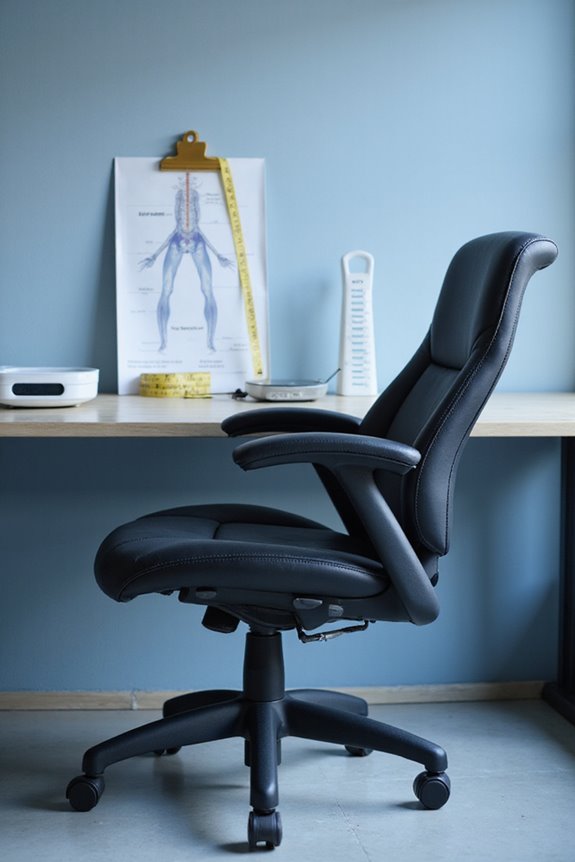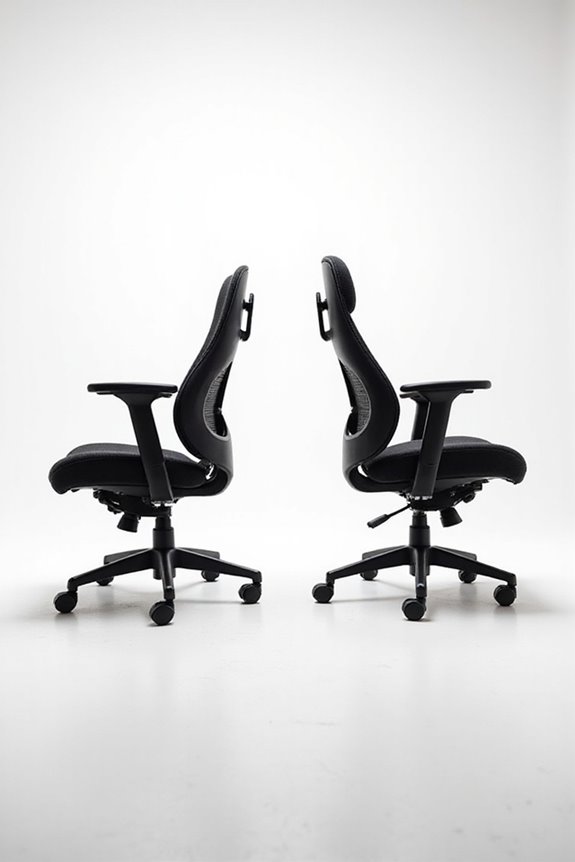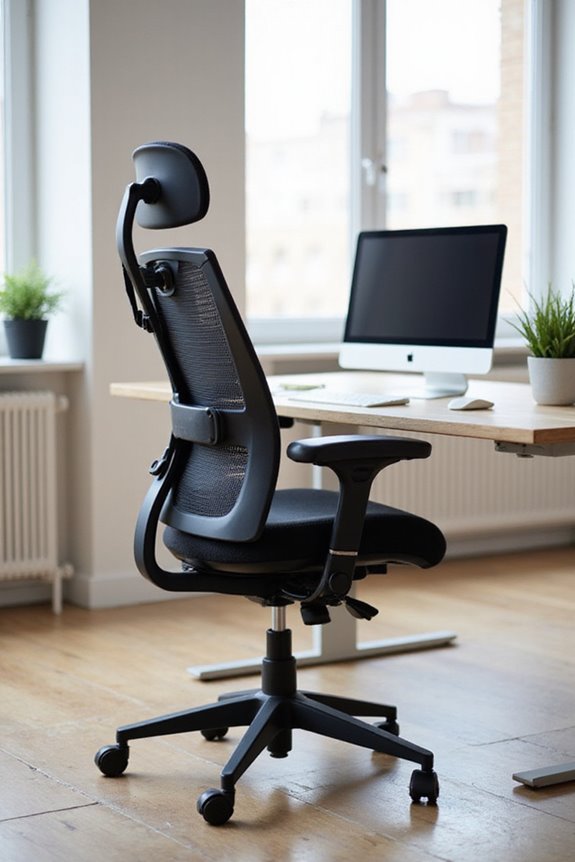To choose the right ergonomic chair for your body type, start by measuring your seat depth, ideally 15 to 18 inches, for thigh support. Make certain the chair height is adjustable for proper spinal alignment. Look for an adjustable backrest with lumbar support to fit your lower back. Customizable armrests are essential for shoulder and wrist comfort. Finally, select a seat width at least one inch wider than your hips and check the load capacity. Continue exploring more important features that suit your needs.
Key Takeaways
- Measure your seat depth, ensuring it provides support without pressure behind the knees, ideally between 14 and 18.5 inches.
- Choose a chair with adjustable height to accommodate your body type and promote proper posture and spinal alignment.
- Look for a backrest that offers lumbar support, adjustable in height and depth, to fit your spine’s natural curve.
- Ensure armrests are adjustable in height, width, and depth to align with your elbows and provide comfortable forearm support.
- Select a chair with a seat width at least one inch wider than your hip width, and confirm the load capacity meets your needs.
Understanding Seat Depth and Structure
When considering an ergonomic chair, understanding seat depth and structure is essential for achieving ideal comfort and support. Seat depth typically ranges from 15 to 18 inches, accommodating most users. Proper seat depth allows for adequate thigh support without applying pressure behind the knees, promoting better circulation. To measure seat depth, I consider the distance from the back of my buttock to the back of my knee. An adjustable seat depth, ideally between 14 and 18.5 inches, is preferable for customization across different body types. If the seat depth is excessive, it can cause discomfort and restrict circulation. Conversely, inadequate depth can lead to poor posture and insufficient support. Additionally, many ergonomic chairs incorporate adjustable lumbar support to enhance overall comfort and promote better posture during extended use.
Importance of Chair Height Adjustability
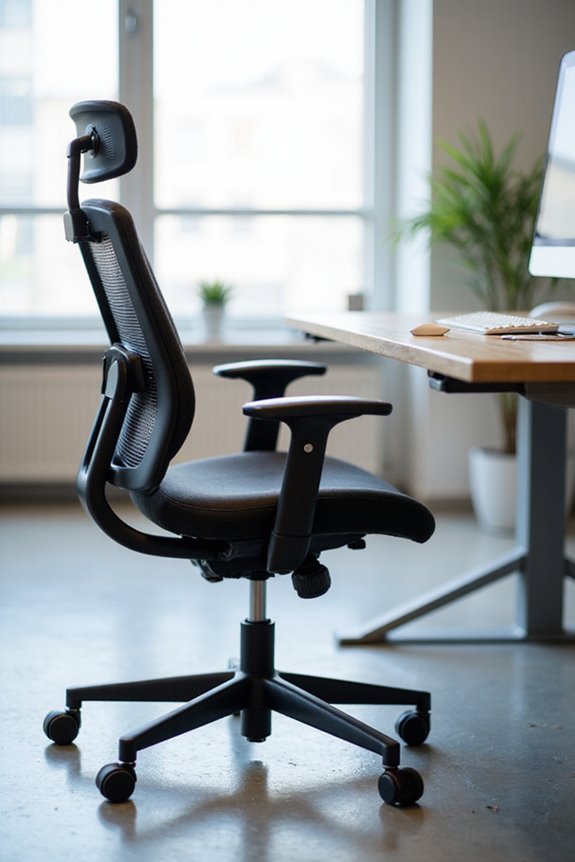
Adjustable chair height is crucial for ensuring that users maintain proper posture while seated, as it directly impacts foot placement and spinal alignment. A chair with a suitable height range accommodates various body types, allowing each user to find their ideal seated position. This adjustability helps prevent discomfort and reduces the risk of developing musculoskeletal disorders.
Additionally, a chair’s tilt function enhances comfort by enabling users to adjust their position throughout the day. This flexibility is essential in dynamic work environments, where multiple individuals may share the same space. By incorporating these adjustable features, ergonomic chairs support not only individual health but also overall workplace productivity and adaptability.
Backrest and Lumbar Support Features
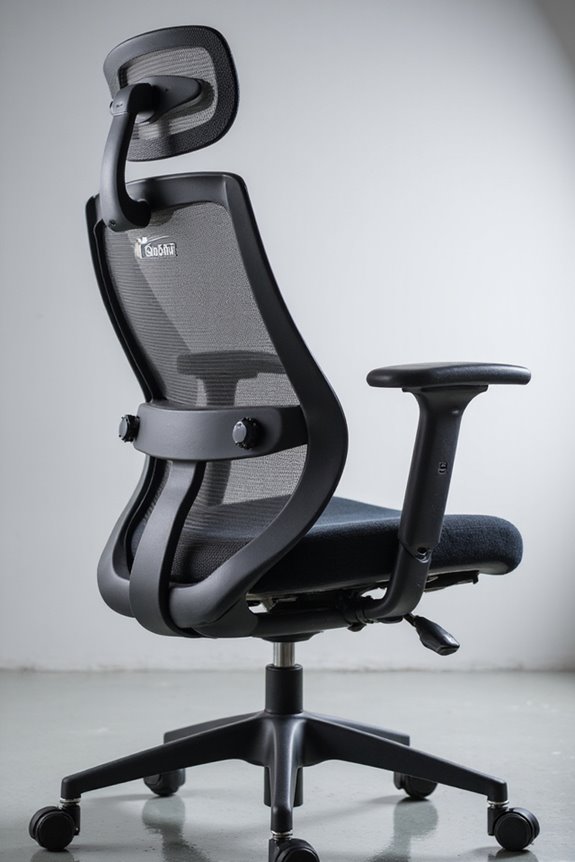
Finding the right ergonomic chair goes beyond just adjusting the height; backrest and lumbar support features play a significant role in overall comfort and well-being.
- Backrest Design: Look for contoured backrests that support your upper back and shoulders. High backrests offer additional stability, while various backrest materials, like mesh or fabric, can impact your comfort level.
- Lumbar Support: Adjustable lumbar support is essential for customizing the height and depth of the lumbar curve. This feature helps maintain good posture and can relieve back pain.
- Integration: Verify that the lumbar support is integrated with the backrest design. This combination promotes thorough spinal support, enhancing both comfort and productivity during long hours of sitting. Additionally, proper maintenance of your ergonomic accessories can significantly contribute to your overall sitting experience and health.
Customizing Armrests for Comfort

Customizing armrests for comfort is vital, as proper arm support can greatly enhance your overall sitting experience. First, consider height adjustment; armrests should align with your elbows at a 90-degree angle to reduce neck and shoulder stress. Next, width adjustment allows for a better fit, accommodating various body sizes and tasks. Some chairs offer sliding arm pads or bolt-based adjustments for this purpose. Depth adjustment is important for ideal forearm support without restricting movement. If you’re looking for versatility, pivot adjustments can align armrests with your forearm angle, promoting a natural wrist position. Finally, think about armrest materials and alternative armrest designs to further enhance comfort, ensuring a personalized and ergonomic workspace. Additionally, look for ergonomic features that reduce strain, as these can significantly improve your sitting experience over longer periods.
Selecting the Right Seat Width and Load Capacity
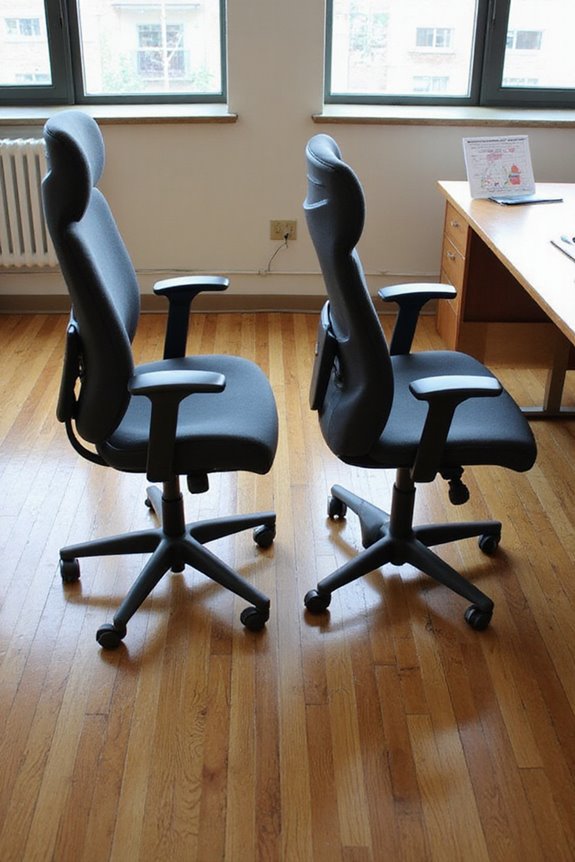
After guaranteeing your armrests are customized for comfort, the next step involves selecting the right seat width and load capacity for your ergonomic chair. First, consider your seat measurement; it should be at least one inch wider than your hip width to guarantee comfort and proper posture. Standard chair widths range from 17 to 20 inches, accommodating various body types.
Next, check the load capacity, typically between 250 to 300 pounds for standard models. Choosing a chair that matches your weight distribution is essential for durability and safety. Confirm the chair complements your desk space without restricting movement. Accurate personal measurements will guide you to the right seat width and load capacity, promoting long-term comfort and support.
Frequently Asked Questions
What Materials Should I Look for in an Ergonomic Chair?
When considering ergonomic chairs, I look for breathable mesh for comfort and durability, or memory foam for support. Fabric types matter—durability is key, so I avoid materials that trap heat or wear easily.
How Do I Know if a Chair Is the Right Size for Me?
Finding the perfect chair feels like hunting for gold. I measure chair height to guarantee my feet rest flat, while seat depth should leave a couple of inches between my knees and the edge. Comfort’s key!
Are There Specific Brands Known for Ergonomic Chairs?
When I explore brand comparisons for ergonomic chairs, I find that options like ErgoTune and FlexiSpot stand out for their ergonomic features. It’s essential to contemplate lumbar support and adjustability to find the right fit.
How Much Should I Expect to Spend on a Quality Ergonomic Chair?
Did you know that over 80% of people experience back pain at some point? When budgeting for a chair investment, expect to spend between $200 and $1,500, depending on features and comfort levels.
Can I Test an Ergonomic Chair Before Purchasing?
Absolutely, I always recommend chair testing before buying. It’s essential for a comfort evaluation. Sitting in the chair lets me assess support, adjustability, and overall feel, ensuring it meets my needs for long hours.

